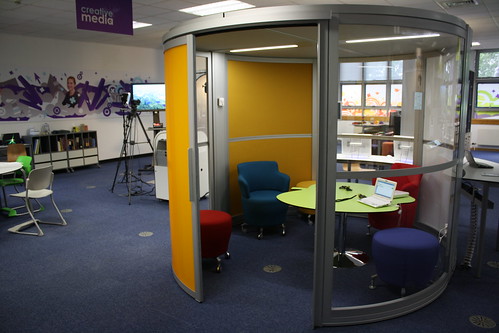The future of education? My visit to RM’s REAL Centre
Can’t see the slideshow? Click here!
The ICT Consultant for the Academy arranged for me to visit RM’s REAL Centre today. I didn’t know much about it beforehand, but when I mentioned it to others some were excited on my behalf whereas others mentioned that it ‘didn’t live up to the hype’. Given that I wasn’t aware of the hype (it was at BETT 2009) I went in fairly unbiased! 🙂
As you can see from the pictures above, the spaces were set out differently from standard classrooms. All together, it worked well and whilst walking around I was impressed. On reflection, however, given that no school’s likely to have all that’s in there, I started thinking about specifics. Here’s my takeaways:
21st century interactive whiteboard
Current interactive whiteboards tie teachers to the front of the classroom and perpetuate at 20th (19th?)-century model of teaching. That’s why I really liked the ‘horizontal [and vertical!] interactive and collaborative surface’ that was on display. It was a combination of three things, really:
- A rotatable (fairly standard) adjustable project table
- An ultra-short throw projector
- A clip-on sensor to the table (surface) for the ‘interactive’ element
The great thing was that not only was the table rotatable and height-adjustable, but had wheels and a single plug so could be easily be moved around learning spaces. 😀
Eye-tracking hardware/software
Although I’ve read about them before and seen videos, it was great to try out an eye-tracking device for myself. It took less than a minute to calibrate and get myself up-to-speed on what to do, and after that I was able to write sentences and get the computer to speak them back to me! The only downside was that, being a contact lens-wearer, my eyes felt a little dry afterward. Felt fairly futuristic, though, and potentially life-changing for some of the profoundly disabled students we’ll have at the Academy.
Inexpensive USB microscopes
I’m sure these have probably been around for ages, but it was my first experience with a USB microscope that was both robust and inexpensive (around £30). It fed real-time images to an Asus Eee PC via a USB connection, which could save them for future reference. With the netbook and small microscope, students are able to go outside and investigate things, come back and show what they’ve found. Loved it. :-p
Soundproof pods
I didn’t get a chance to check out how much these cost, but I think they’re a great idea. The photo above explains what I’m talking about: soundproof, circular ‘pods’ that allow for meetings, speaking and listening exercises, or some quiet study to take place.
I can see these being used in break-out spaces, in reception areas for meetings with parents – for a whole host of things, in fact. The great things was that, whilst they’re soundproof, they’re comfortable and have clear windows so teachers can see what is going on. A great idea.
Student-centred seating
Again, variations of the seating that was on display at the REAL Centre have been seen before, but it was good to see thought going into ergonomics. The seats, along with the tables, on offer could be stacked into a very small space to allow for drama-based activities. It was almost impossible to lean backwards on them such that the front legs came off the floor. You could, however, rock forwards slightly which was pleasing.
Some other seating featured an attached circular table. These moved together on wheels until sat on, whereupon they would lock in place. The swivel chair made for multiple configurations of separate work areas when students are working at computers. Well thought-out. 🙂
Visualizer
Apparently these have been around for ages and, indeed, I seem to remember the Politics department at the University of Sheffield using something similar when I took some modules there in my first year (1999!) However, when paired with a projector you begin to wonder whether an interactive whiteboard isn’t just an expensive luxury that perpetuates an outdated system. Having a visualizer makes examining sources, ‘real-life’ stuff and students’ work much easier and much more likely to happen.
The rest
Obviously there was more than just the above at the REAL Centre, but nothing I hadn’t really seen before. There was Lego Mindstorms stuff, a ‘teacher wall’ to provide space and cupboards around interactive whiteboards, flexible tiered seating areas, chroma key hardware, sensory equipment and a stop-motion animation studio, amongst other things. I’m a big fan of the touchscreen Asus Eee Tops that were on display there but, again, I’ve seen them before.
Conclusion
All in all, a worthwhile and enjoyable day. RM have asked for feedback for which I’m pointing them towards this blog post. I’d advise them either to put price tags on everything or give brochures with clear prices immediately after the tour. It became a bit annoying for me, and embarrassing for them, having to ask how much everything costs at every turn!
You could read about everything that’s in the RM REAL Centre online. You may even have come across half of it in the flesh, so to speak. But having time to be shown it all in one place and think about how it could transform teaching and learning is a powerful thing. I’d recommend that if you can, you go and have a look. 😀


![Reblog this post [with Zemanta]](http://img.zemanta.com/reblog_e.png?x-id=5b86be99-dd18-4441-b241-6c1dfb99181d)
